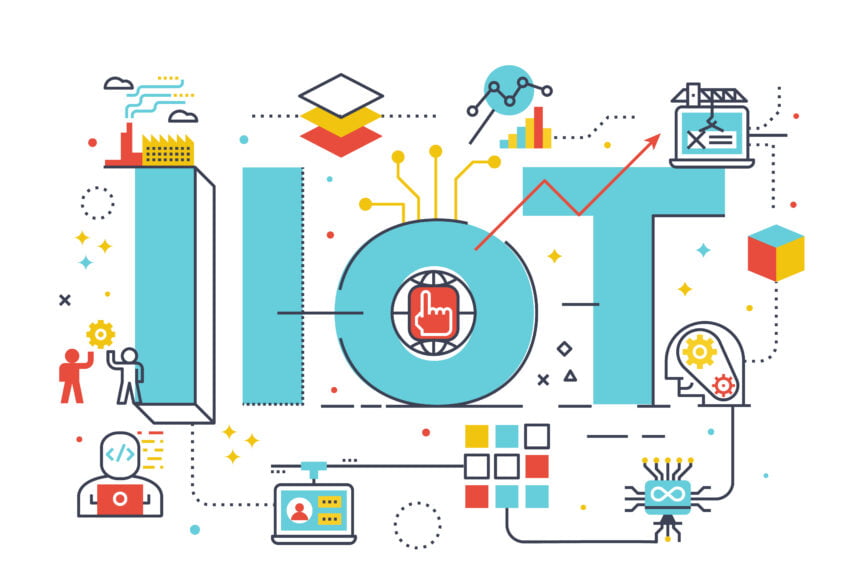For the first time, the Internet of Things (IoT) appeared in 1999. The basis of this concept is data transmission between devices that allows them to gather, process, and analyze information using special equipment and software. In other words, the IoT system means connecting things (equipment) to the Internet for improving the quality of people’s life. One of its varieties is the Industrial Internet of Things (IIoT).
Many technologies can be considered IoT, from stream analytics to the artificial intelligence. In this article, we will review such directions of the Internet of Things as indoor navigation systems and indoor tracking. Moreover, we will describe how these solutions are applied in various spheres of activity.
What is Indoor Navigation and Tracking?
Indoor navigation belongs to effective directions of IoT aimed at creating routes inside buildings. Its organization can be performed using various technologies – iBeacon, Wi-Fi, UWB, etc. The operating principle of the indoor wayfinding system is based on the use of special sensors that are installed in different places in the building and function using radio waves, acoustic signals, and magnetic fields.
In the modern world, indoor navigation is applied in many spheres. It can be used for the following purposes:
- creating digital maps of places;
- building optimal routes inside premises;
- developing guides for museums and other cultural institutions
Along with indoor navigation, the Internet of Things includes indoor tracking that provides for the monitoring of visitor flows or asset monitoring. While implementing the system, it is possible to track the movements of objects in real-time, adjust the routes of special equipment, and prevent possible emergencies. Using indoor tracking at enterprises significantly enhances occupational safety and ensures the effective optimization of internal business processes.
Application of Navigation and Tracking Systems
Industrial Internet of Things (IIoT) finds application in various spheres, such as production, logistics, trade, healthcare, and transport industry. Importantly, in the Covid-19 pandemic, indoor navigation, and asset tracking make it possible to keep social distancing and prevent the infection of the staff and visitors.
Healthcare
The navigation inside medical institutions is a powerful tool that helps to improve the quality of customer service and increase patient satisfaction. Indoor wayfinding systems can be used in several ways:
- convenient navigation for patients and medical staff inside hospitals;
- tracking the movement of the patients requiring special consideration;
- a quick search of medical equipment;
- ensuring visitor and staff safety.
Logistics and Warehousing
In warehousing and logistics, the tracking platform monitors the movement of equipment or goods in real-time. Using this system, one can get detailed information on asset location, analyze movement, and monitor staff performance. Thanks to IoT systems, it is much easier to manage enterprises and adjust the daily tasks of the staff. The system implementation allows companies to increase logistics process efficiency, reduce operational costs, and save resources due to company performance optimization.
So, for one large warehouse, Navigine developed a system for determining the location of objects (cargo, materials, goods) inside the warehouse, as well as tracking vehicles in real-time. With the help of the mobile application, workers were able to create convenient routes to racks, pallets, or goods, as well as quickly find warehouse vehicles. High tracking accuracy was achieved through the use of innovative internal tracking systems and high-quality IoT equipment. As a result, work efficiency increased by 5%.
Industry
In the production sector, IoT technologies ensure complex solutions for reducing costs and increasing object safety. Using indoor navigation platforms, it is possible to make interactive maps of buildings, quickly search moving objects, and define the exact location of equipment and machines in real-time. Using IoT in the industry offers businesses some advantages:
- reducing time spent on searching objects.
- possibility to plan daily tasks more effectively;
- obtaining analytics;
- instant response to emergencies.
For one machine-building holding, an indoor tracking system was developed with the functions of traffic control, visiting hazardous areas, tracking the movement of objects inside the building in real-time. The equipment used was Bluetooth low-energy beacons placed around the perimeter of the building and smart helmets for workers. Company executives gained access to a real-time system that recorded the movement history of each staff, marked the building into important zones to track movements inside/out of each zone and the number of visits to the zone, and made it easy to find the staff on a digital map.
As a result of the introduction of the system, the overall labor productivity increased by 20%. The number of accidents and industrial injuries has decreased.
Shopping Centers
Using the mobile application with the function of indoor navigation, visitors get the possibility to build routes around shopping centers and quickly search the necessary shops. The use of the technology increases the loyalty of clients and contributes to maximizing profits. Moreover, business representatives can gather detailed analytics that helps to understand better the behavior of visitors inside shops.
Airports and Railway Stations
In many cases, indoor navigation is used for managing the work of airports and railway stations. It helps passengers to build routes to the necessary places (terminals, cafes, restrooms, etc.), while the management can send to their client’s useful push notifications, collect analytics, and track assets.
Marketing
The technology lets businesses create relevant content and send it to users for attracting new clients. Targeted push notifications can contain information on discounts, promo actions, and special offers. Increasing visitor loyalty and improving the efficiency of advertising campaigns can be added to the list of expected benefits from marketing communications.
Ensuring Working Safety During the Pandemic
The Internet of Things opens wide possibilities for increasing labor safety in an environment of Covid-19. Thanks to indoor tracking technologies, it is possible to solve several important tasks:
- keep social distancing;
- track the contacts and the time of interaction between the employees.
Such IoT technologies, indoor navigation, and indoor tracking are beneficial for enhancing the efficiency of different business spheres. Using them, companies can monitor the movement of any objects inside buildings, create interactive maps, analyze the company performance, and successfully optimize business processes.







